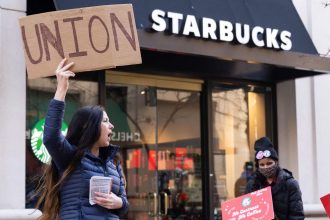Amazon is planning to show personalized ads on its Dash Cart. It’s a move that can squeeze more value out of its nascent smart grocery store shopping cart and potentially unlock revenue to help its physical stores generate more profit and expand.
The personalized ads would show up on the display screen attached to the Dash Cart while people shop, according to an internal document obtained by Insider. Dash Cart users are required to sign in to the cart using an Amazon or Whole Foods account. This will allow Amazon to track impression reporting and conversion attribution of each ads, the document said.
Amazon rolled out the latest version of the Dash Cart last year with more space and an upgraded screen that shows things like real-time receipts and promotions. At the time, Amazon made the Dash Cart available at select Whole Foods stores, in addition to many of its Fresh grocery stores.
Once personalized ads are rolled out, Dash Cart users would get ads based on things like the area of the store they are in. For example, it will be able to show ads for nearby items to the cart, with a max radius of 12 feet, according to the document. The radius is slated to expand once the Dash Cart switches to a “global coordinate system,” it said.
Amazon is also planning to show ads of complementary products to the items already placed in the cart, the document said. The ads will also have “out of stock awareness,” meaning it will be able to tell whether the advertised product is in-stock or not at a specific location.
“This experience presents a unique advertising opportunity for Amazon as we have an unprecedented wealth of contextual data which we can use to serve hyper-relevant ads to the customer,” the document said.
The move would be for the latest iteration of the Dash Cart, which launched in 2020 as part of Amazon’s effort to provide a cashierless shopping experience at its physical stores. Dash Cart users are able to automatically check-out products placed in the cart without having to go through a cashier.
In an email to Insider, Amazon’s spokesperson said Dash Carts already offer in-store product search and mapping through its screen, but didn’t comment on plans for personalized ads.
“Customers love these features as it helps them find products easily at stores and enhances their shopping experience,” the spokesperson said.
Sponsored ads, which are purchased by individual brands and merchants, appear to be a key part of the new advertising effort on the Dash Cart. The internal document said there could be some kind of bidding mechanism for the Dash Cart sponsored ads, likely similar to how it works on Amazon’s online marketplace.
Amazon had planned to launch the new personalized ads by the third quarter of 2023, the document said. It’s unclear why it’s being delayed.
Insider previously reported that Dash Cart screens are one place Amazon is aiming to place ads, as part of a broader effort to sell digital ads inside its physical stores. Amazon Fresh stores are “dependent on advertising” to turn a profit and expand, an internal document said.
New ad placements in its physical stores, like on the Dash Cart, could potentially turn into a lucrative new revenue source for Amazon going forward. Investment firm Jefferies wrote in a note this week that “the real prize in grocery” for Amazon is the opportunity to tap into the over $200 billion advertising budget US consumer brands spend annually. It also predicted every 1% market penetration by Amazon in the US grocery and consumer ad spend “will drive $18 billion in incremental sales” for the company.
Amazon doesn’t disclose sales from its grocery business. But its physical stores revenue, mostly coming from Whole Foods and its Fresh grocery stores, grew just 6% year-over-year last quarter to $5 billion. The advertising business, meanwhile, grew 22% to $10.7 billion in sales.
Do you work at Amazon? Got a tip?
Contact the reporter Eugene Kim via the encrypted-messaging apps Signal or Telegram (+1-650-942-3061) or email ([email protected]). Reach out using a nonwork device. Check out Insider’s source guide for other tips on sharing information securely.
Read the full article here





